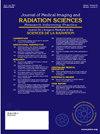Diagnostic radiography students’ neonatal mobile X-ray imaging infection prevention and control practices
IF 2
Q3 RADIOLOGY, NUCLEAR MEDICINE & MEDICAL IMAGING
Journal of Medical Imaging and Radiation Sciences
Pub Date : 2025-04-15
DOI:10.1016/j.jmir.2025.101904
引用次数: 0
Abstract
Introduction
Neonates represent a unique population with complex medical needs. Diagnostic medical imaging is crucial for diagnosing and treating their conditions, often utilising mobile imaging equipment. A key aspect of providing mobile X-ray imaging for neonates is infection prevention and control (IPC). This study investigated the IPC practices of diagnostic radiography students conducting mobile X-ray imaging in neonatal intensive care units (NICUs).
Method
This quantitative descriptive cross-sectional study employed purposive sampling and used an online questionnaire to collect data from diagnostic radiography students at a higher education institution in Gauteng, South Africa. The data was analysed using descriptive and inferential statistics.
Results
The survey had a response rate of 51.1% (n=141, N=276), primarily from the second-year cohort (44.7%). Most participants (n=132; 93.6%) had access to dedicated NICU and IPC policies, but only 63.1% (n=89) were familiar with the IPC protocols. The majority of participants (n=134; 95%) recognised the importance of limiting cross-contamination in the NICU. Participants rated their IPC practices as average (n=60; 49.6%) and high (n=64; 45.4%). More reported cleaning the mobile X-ray machine (n=89; 63%) and washing hands (n=114; 81%) before examinations rather than after, with image receptors (n=106; 75%) mostly cleaned after the examination.
Conclusion
The IPC practices of diagnostic radiography students during mobile X-ray imaging in the NICU were inconsistent. Most students understood the importance of IPC; however, inconsistencies in cleaning mobile X-ray machines, image receptors and radiographic markers were reported. It is necessary to explore the reasons for these divergent IPC practices to develop strategies to enhance IPC practice compliance.
诊断放射学学生新生儿移动x线影像感染防控实践
新生儿是具有复杂医疗需求的独特人群。诊断性医学成像对于诊断和治疗他们的病情至关重要,通常使用移动成像设备。为新生儿提供移动x射线成像的一个关键方面是感染预防和控制。本研究调查了诊断放射学学生在新生儿重症监护病房(NICUs)进行移动x线成像的IPC实践。方法采用有目的抽样和在线调查问卷的方法,对南非豪登省一所高等教育机构的放射诊断学学生进行定量描述性横断面研究。使用描述性和推断性统计对数据进行分析。结果调查的应答率为51.1% (n=141, n= 276),主要来自第二年队列(44.7%)。大多数参与者(n=132;93.6%的患儿能够使用专门的NICU和IPC策略,但只有63.1% (n=89)熟悉IPC协议。大多数参与者(n=134;95%)认识到限制新生儿重症监护室交叉污染的重要性。参与者将他们的IPC实践评为平均水平(n=60;49.6%)和高(n=64;45.4%)。更多报告清洁移动x光机(n=89;63%)和洗手(n=114;81%)在检查前而不是检查后,有图像受体(n=106;75%)检查后大多清理干净。结论诊断学学生在NICU移动x线影像中的IPC实践不一致。大多数学生理解IPC的重要性;然而,在清洁移动x光机,图像受体和放射标记不一致的报道。有必要探讨这些IPC实践差异的原因,以制定提高IPC实践合规性的策略。
本文章由计算机程序翻译,如有差异,请以英文原文为准。
求助全文
约1分钟内获得全文
求助全文
来源期刊

Journal of Medical Imaging and Radiation Sciences
RADIOLOGY, NUCLEAR MEDICINE & MEDICAL IMAGING-
CiteScore
2.30
自引率
11.10%
发文量
231
审稿时长
53 days
期刊介绍:
Journal of Medical Imaging and Radiation Sciences is the official peer-reviewed journal of the Canadian Association of Medical Radiation Technologists. This journal is published four times a year and is circulated to approximately 11,000 medical radiation technologists, libraries and radiology departments throughout Canada, the United States and overseas. The Journal publishes articles on recent research, new technology and techniques, professional practices, technologists viewpoints as well as relevant book reviews.
 求助内容:
求助内容: 应助结果提醒方式:
应助结果提醒方式:


